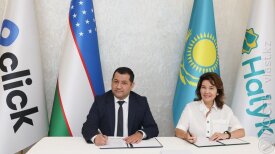This article was first published on Earth.Org's website - https://earth.org/ on 1 July 2025 and is reposted here as part of an agreement with Earth.Org.
Осы мақаланың қазақша нұсқасын оқыңыз.
Читайте этот материал на русском.
Kazakhstan has lost 21% of its per capita water availability since 1999. Only 42% of Kazakhstan’s water is available for consumption due to outdated infrastructure and poor management. Over 45% of available water is transboundary, meaning it comes from sources such as the Irtysh and Ili rivers from China and the Syr Darya from neighboring Kyrgyzstan and Uzbekistan, making Kazakhstan vulnerable to politics and foreign water mismanagement.
The poor irrigation productivity, at less than $0.5 per cubic meter, means that for every cubic meter of water (1,000 liters) used for irrigation, the resulting agricultural output generates less than half a dollar in value. Combined with unmaintained infrastructure and low returns from water-intensive crops this also plays a role, translating into huge missed economic opportunities. The inadequate sanitation alone costs the government some $750 million per year, compared to $500 million in investments needed to close this gap.
Glacial Threat
Kazakhstan’s water sources are heavily dependent on glacier-fed rivers from the Tien Shan mountains. Glaciers in this region have already lost about 30% of their mass and may retreat by another half by 2050.
The initial deluge in meltwater is temporary; soon enough, these rivers will dry out in the summer months, when water is most needed for cooling and irrigation, eventually leading to seasonal shortages and ecological collapse.
Agriculture: Thirsty and Wasteful
In 2021, 63% of annual water withdrawal in Kazakhstan was spent on agriculture, making it the largest sector of water waste, compared to 19% for domestic use. It is reported that only half of the water determined for agricultural use is utilized effectively or reaches the crops.
Additionally, only 16% of all irrigated land uses modern irrigation techniques, such as drip or sprinkler systems. The government introduced a policy on Water Resources Management (2023–2029), which acknowledges these challenges and aims to reduce agricultural water loss through main canals from 20% to 15% by 2029.
The agricultural inefficiencies not only stress the country’s water resources but also put additional pressure on food security and economic stability.
Unequal Access to Water
Despite Kazakhstan’s efforts to improve water infrastructure, differences between urban and rural areas still exist. While urban centers enjoy access to centralized water and sanitation, rural residents face challenges that affect their health and quality of life.
As of 2024, around 99.5% of urban residents had access to clean water, with 97.8% of rural settlements having similar access. Access to piped water shows a more pronounced discrepancy. While 94% of urban households are connected to piped water systems, the number is closer to 60% for rural households – forcing people to rely on other sources of water like public standpipes or wells.
The differences in water access between urban and rural areas are not only an infrastructural issue; they also have serious implications for public health, economic development, and social equity. Addressing these challenges requires investments in rural water infrastructure, community engagement, and policy reforms targeted at ensuring equal access to water sources across Kazakhstan.
Geopolitics
Kazakhstan’s water resources, as was mentioned earlier, are dependent on transboundary rivers – particularly the Ili and Irtysh rivers, which originate in China and are vital for Kazakhstan’s agriculture, industry, and ecosystem in general.
Negotiations between Kazakhstan and China to reach an agreement on water equitability have been ongoing. But despite some progress, such as the joint construction of hydraulic facilities on shared rivers like the Khorgo, a broad agreement on water allocation remains ambiguous.
The situation is complicated by Kazakhstan’s dependence on other transboundary rivers such as the Syr Darya, which flows through Kyrgyzstan and Uzbekistan before reaching Kazakhstan. Effective use of these water resources requires regional cooperation, which is challenging due to differing national interests and priorities.
Kazakhstan has taken steps to reduce tensions with its neighbours. For example, Kazakhstan and Uzbekistan installed transboundary water meters to monitor water consumption and share data, improving cooperation and transparency.
However, the challenge remains because of the lack of binding international agreements and the ever-increasing demand for water in the region, depicting risks to Kazakhstan’s water security. Addressing the geopolitical challenges is essential for sustainable water management and preventing conflicts over this vital resource.
What the Future Holds
The predictive model Earth.Org has built depicts an uneasy reality. Renewable internal freshwater resources have been in decline since the 1990s, and forecasts show this trend will continue, potentially dropping to 2,750 cubic meters by 2031.
The widening uncertainty interval emphasizes the importance of action – policy changes, investments in water-saving technologies, and improved regional cooperation.
Water scarcity has further effects on public health, economic resilience, and national security. The best time to act is now.
Поддержите журналистику, которой доверяют.











